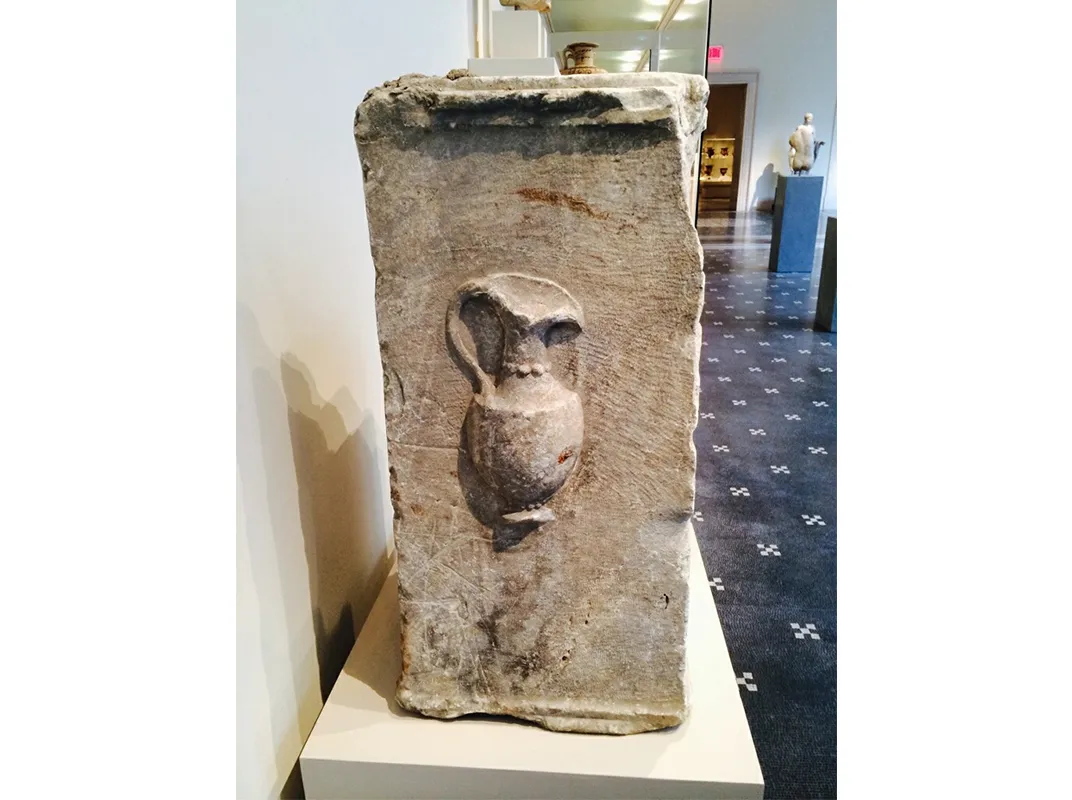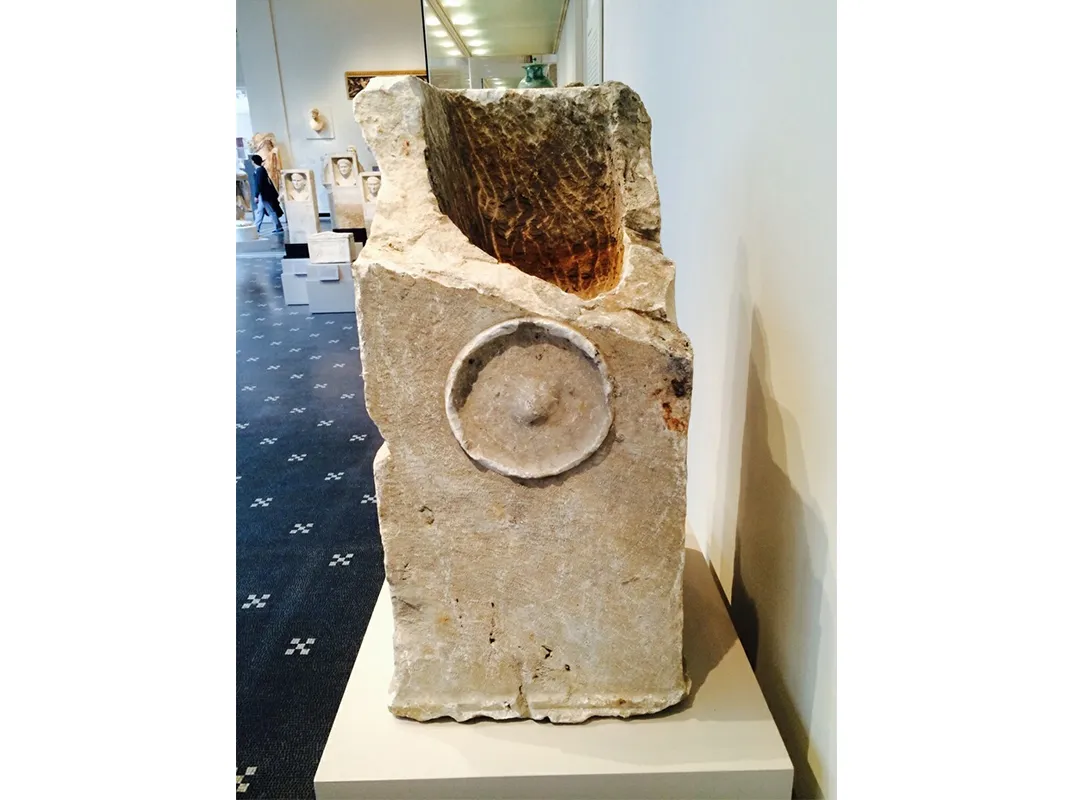Found in the Remains of a Former Gilded Age Mansion, an Ancient Roman Artifact Reveals Its Secrets
Bridging three periods of income inequality, the gravestone of a former slave finds a new home
/https://tf-cmsv2-smithsonianmag-media.s3.amazonaws.com/filer/4f/53/4f5388b3-0b1a-4117-87e7-20896b979660/img_20150527_153628048-wr.jpg)
One day in the summer of 2015, New York real estate developer Andy Todd received a curious email from one of his contractors. Punctuated by 25 question marks, the message, sent by excavator Tom Peterson, clearly expressed confusion and from an attached photo, Todd could see why. Peterson had unearthed a mini-fridge-sized object from what was to be the foundation of a luxury home. Grotesquely heavy and made of ivory-hued marble, the object was inscribed across its face with unintelligible lettering. It looked old, maybe even ancient—and vaguely Roman. But what was it doing here, 13 miles north of Manhattan?
The answer would shed light on ancient Roman inequality and two American eras to match.
Todd is the developer of Greystone on Hudson, a 100-acre tract along the Hudson River that stretches between the affluent towns of Irvington and Tarrytown, in Westchester County. Formerly the site of palatial homes belonging to 19th-century one-percenters, including railroad magnate Jay Gould, banking scion Harold Lehman, and American Tobacco executive Robert Dula, the land occupies a portion of what was once known as Millionaire’s Row. With Greystone on Hudson, Todd aims to resurrect the past, offering 21 individual estates inspired by Gilded Age residences.
When he saw the email from Peterson, Todd was entertaining a friend visiting from California. But he was intrigued by the photograph. The object was freshly disinterred—pulled with heavy machinery (look away, archaeologists) from the ground. For something that had until recently been encased in dirt, though, it appeared remarkably clean, its lettering legible. And there was further cause for curiosity: The stone had been extracted from a plot once occupied by a mansion owned by Josiah Macy, a partner of John D. Rockefeller’s in Standard Oil. Todd drove to the site to get a closer look.
The mysterious object had a large chunk missing from its upper right corner. A bas-relief wine jug decorated its left side, and its upper third had been hollowed to create a basin. Todd wondered whether perhaps it had been used as a planter. The lettering looked Latin, however, and though Todd doesn’t read the language, he suspected that the “CLAVD” that appeared near the beginning of the inscription alluded to Claudius, the Roman emperor who ruled from 41 to 54 AD. Using Google Translate, he came up with an approximation for the rest of the text.
Next, he scoured the web for some of the translated phrases—“To the Spirits of the Departed”; “Imperial Freedman of the Emperor.” Before long, he arrived at the official website of the Corpus Inscriptionum Latinarum, a kind of reference bible for researchers of ancient Roman history, known in the biz as the C.I.L. At 17 volumes comprising 70 folio-sized books, the C.I.L is massive. It contains entries on some 180,000 inscriptions found on artifacts discovered (mostly) in various parts of the former Roman Empire. But the majority are not sufficiently notable to lend themselves to Googling. Todd’s find, on the other hand, seemed to have some profile. What he’d discovered, he read, was a funerary cippus—a tombstone—belonging to one Saturninus, a former slave who, given his freedom, had become an administrator with the imperial civil service.
If original, the monument dated to the first century AD, and Todd had good reason to believe that it was. With some additional research, he managed to pinpoint the last known location of the monument catalogued in the C.I.L.—an 1893 auction at the Villa Borghese, in Rome. The buyer was Caroline Louise Everitt, Macy's widow.
Though old interior photographs of the Macy mansion showed that it had been decorated liberally with antiquities, Todd could find no evidence of the cippus. The mansion had burned down in 1976, a period marked by an unusual number of local fires, many of them attributed to ancient heating and electrical systems—and to smoking in bed. In the aftermath, the cippus was buried and forgotten. Serendipitously, the friend that Todd was hosting at the time of its re-discovery had a brother-in-law who happened to work at New York’s Metropolitan Museum of Art, on the same floor as a guy who he thought might know about this sort of thing: Christopher Lightfoot.
A graduate of Oxford, where he wrote his doctoral thesis on the eastern frontier of the Roman Empire, Lightfoot has been with the Met since 1999, when he was recruited to head up the museum’s Roman collections. After looking at photos of the artifact, Lightfoot confirmed that the cippus was genuine and identified a not-entirely-minor translation error in the C.I.L. entry. In authenticating the artifact, Lightfoot said, the Villa Borghese auction records were extremely helpful. Though the tombstone of a bureaucratic functionary would make unlikely quarry for counterfeiters, establishing chain of custody is crucial to validating the provenance of ancient objects.
Lightfoot had more to share on Saturninus, the Roman whose tombstone Tom Peterson had found. The hollowed area that caused Todd to mistake it for a planter, said Lightfoot, had once contained the ashes of the departed Saturninus and, later, possibly those of his wife, Flavia Saturnina, who’d handled her husband’s funerary arrangements. The urn’s lid had been lost.
Both man and wife were freedmen, though the inscription suggests, according to Lightfoot, that Flavia Saturnina was emancipated somewhat later, during the Flavian dynasty, which began in 68 AD, while Saturninus was freed by Claudius, who died in 54 AD. (The translation error that Lightfoot noted in the C.I.L. entry pertains to the tombstone’s Flavian reference, which currently goes unmentioned in the text.)
Saturninus, personally, has no great historical significance, nor does his cippus represent a triumph of craftsmanship or design. The find’s importance is evidentiary. “Particularly for people who study Roman imperial administration, this is a very significant stone,” Lightfoot said. “It’s possibly the earliest inscription to attest to freedmen as imperial administrators.”
Prior to Claudius’ reign, former slaves couldn’t serve as official representatives of the empire. Claudius did away with the rule as a rather clever way of establishing a stable of fiercely loyal civil servants. Saturninus seems to have been among the first wave of former slaves given such a position, and his tombstone provides physical proof of a shift in Roman governance.
“An awful lot of ancient stones were taken from Italy during the Grand Tour,” Lightfoot said, referring to the long, culture-centric sojourns in Italy and France that were popular among wealthy Europeans between the mid-17th and mid-19th centuries. “So there are a lot of these things floating around Europe. But here in the U.S., this kind of find is very unusual, if not unique.”
Since his find was verified, Todd has loaned the cippus to the museum, where it was recently installed, and where it will remain on display for three years. On a recent afternoon, he visited the exhibit with Lightfoot. The gravestone stands on a pedestal against a wall near the center of the main Roman gallery—a bright, airy, high-ceilinged hangar peopled with pearly monuments and shuffling retirees. The ancient grave is flanked by exhibits of small human heads sculpted from white stone.
For Todd, the discovery is both unique and entirely on-brand. Greystone on Hudson has benefited, he said, from buyers’ interest in the site’s Gilded Age associations—its historic exclusivity. So far, three Greystone homes, which are priced from $5 million to $25 million, have sold. The exterior of another was recently completed on the site of the Macy mansion. With 18,359 square feet, nine bedrooms, and two kitchens, it is priced at just under $13 million.
In recent years, economists including Thomas Piketty, the celebrated author of Capital In the Twenty-First Century, have compared the current extent of income inequality in the United States to the Gilded Age. In 2009, a study by historians at Stanford and the University of Texas found that the degree of egalitarianism in Rome during the second century A.D.—about 100 years after the death of Saturninus—compared favorably with the US today. This was, mind you, a society built on the backs of slaves.
“The aristocracy maintained itself by taxing the provincials,” said Lightfoot. It was in this capacity that Saturninus had served, as a collector of inheritance taxes—a career path that seems unlikely to delight the residents of Todd’s development. Lightfoot pointed to a portion of the inscription:
PROVINCIAE [For the province]
ACHAIAE [of Achaia (Greece)]
He allowed himself a sly grin. “That must have been a difficult job in Greece,” he mused. “Collecting taxes. After all, it’s still quite difficult today.”

